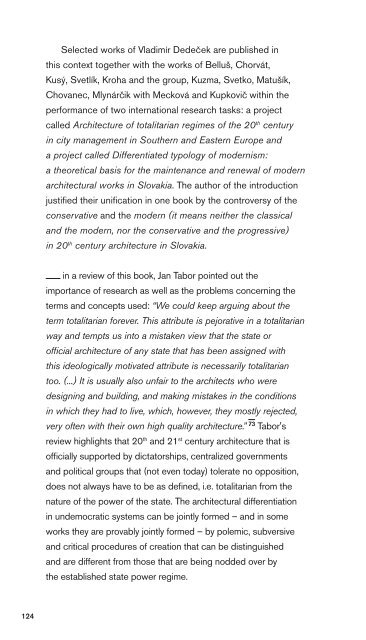sng_2016-05-12_high-single-crop_k3
You also want an ePaper? Increase the reach of your titles
YUMPU automatically turns print PDFs into web optimized ePapers that Google loves.
Selected works of Vladimír Dedeček are published in<br />
this context together with the works of Belluš, Chorvát,<br />
Kusý, Svetlík, Kroha and the group, Kuzma, Svetko, Matušík,<br />
Chovanec, Mlynárčik with Mecková and Kupkovič within the<br />
performance of two international research tasks: a project<br />
called Architecture of totalitarian regimes of the 20 th century<br />
in city management in Southern and Eastern Europe and<br />
a project called Differentiated typology of modernism:<br />
a theoretical basis for the maintenance and renewal of modern<br />
architectural works in Slovakia. The author of the introduction<br />
justified their unification in one book by the controversy of the<br />
conservative and the modern (it means neither the classical<br />
and the modern, nor the conservative and the progressive)<br />
in 20 th century architecture in Slovakia.<br />
in a review of this book, Jan Tabor pointed out the<br />
importance of research as well as the problems concerning the<br />
terms and concepts used: “We could keep arguing about the<br />
term totalitarian forever. This attribute is pejorative in a totalitarian<br />
way and tempts us into a mistaken view that the state or<br />
official architecture of any state that has been assigned with<br />
this ideologically motivated attribute is necessarily totalitarian<br />
too. (...) It is usually also unfair to the architects who were<br />
designing and building, and making mistakes in the conditions<br />
in which they had to live, which, however, they mostly rejected,<br />
very often with their own <strong>high</strong> quality architecture.” 73 Tabor's<br />
review <strong>high</strong>lights that 20 th and 21 st century architecture that is<br />
officially supported by dictatorships, centralized governments<br />
and political groups that (not even today) tolerate no opposition,<br />
does not always have to be as defined, i.e. totalitarian from the<br />
nature of the power of the state. The architectural differentiation<br />
in undemocratic systems can be jointly formed – and in some<br />
works they are provably jointly formed – by polemic, subversive<br />
and critical procedures of creation that can be distinguished<br />
and are different from those that are being nodded over by<br />
the established state power regime.<br />
<strong>12</strong>4



